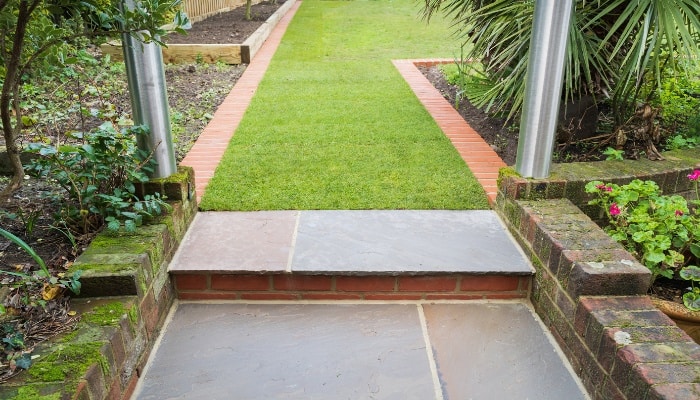Many people overlook the importance of landscape edging, considering it to be of minor significance. Yet, if you want to preserve the aesthetics of your landscape and ensure its proper upkeep, it is crucial to consider methods of defining its borders.
A well-designed edge adds more visual value to the landscape as a whole. The following 26 edging ideas should give you the inspiration to define your landscape in a beautiful and unique way.
1. Concrete Edging Stones
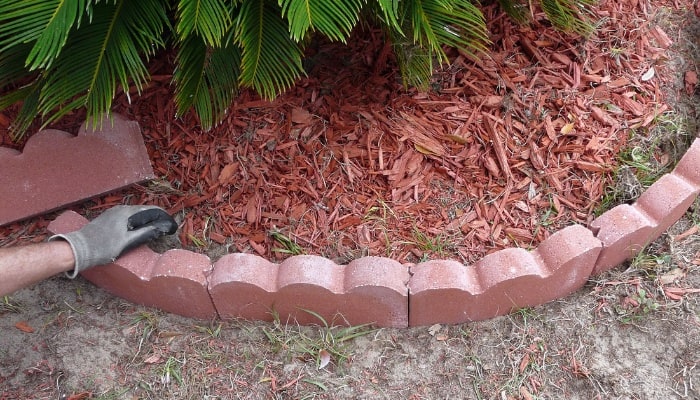
Concrete edging stones are a more permanent solution, and they can be used around the perimeter of the garden and lawn to define the boundaries of flower beds.
Choose stone colors that match the overall design and prevailing colors of the garden and the plants.
If desired, you can use concrete to hold the stones together, or you can simply set them in place and nestle them into the ground until secure.
2. Flagstone
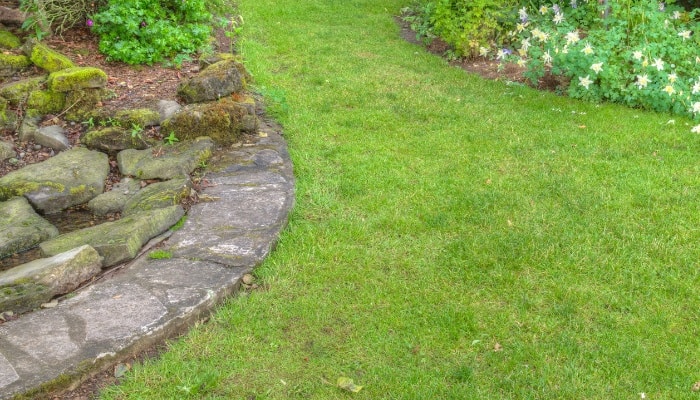
Flagstone is used to pave patios and walkways, but if you have the time and patience, you can also use it to edge around flower beds, patches, and the intricate design of the garden.
Flagstone, however, isn’t great for edging the perimeter of the landscape, and keep in mind that you might need to edge the flagstone walkway or border itself with more elevated stones or wood.
3. Bricks
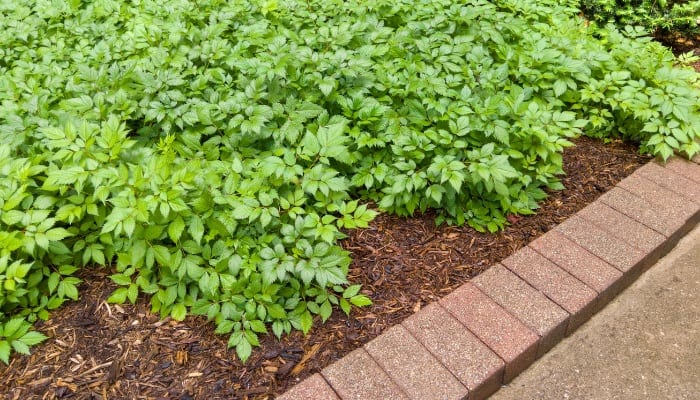
Bricks, like flagstone, are more of an ornamental edging solution and can be used to define veggie patches, walkways, and ornamental beds.
They’re usually flat and laid at ground level. This cost-effective solution comes in different shades of red and can be repainted to fit into your landscape theme.
4. River Rock
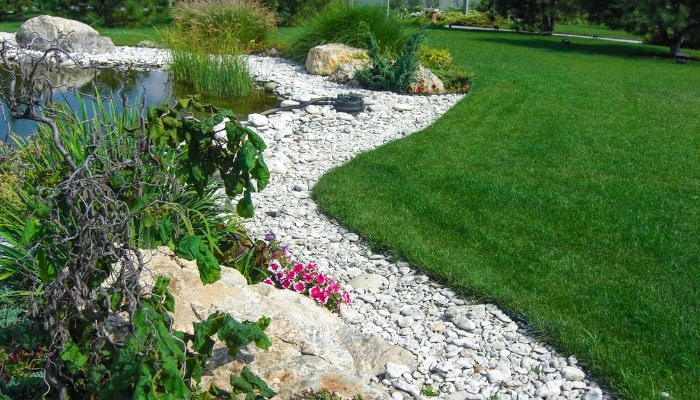
River rock is an excellent way to create a natural yet exquisite and unique border. It’s also a great way to express yourself artistically and come up with a pleasing, soothing design.
It’s all about choosing the right rock sizes and arranging them in a way that displays their natural colors and smooth surfaces.
5. Poured-Concrete Border
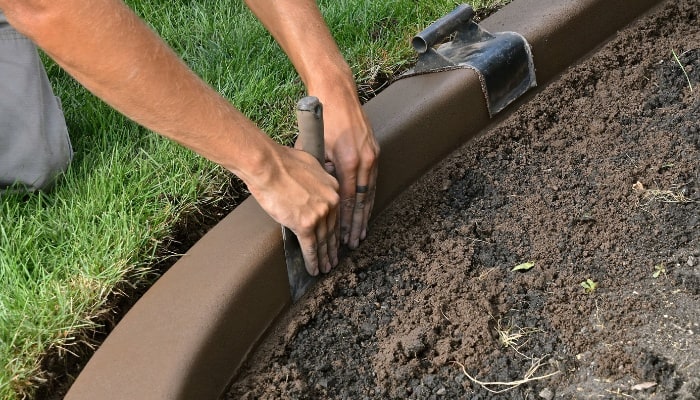
With poured-concrete borders, you can have a permanent border that will endure for many years to come.
If you don’t like the color of the concrete, you can either paint it or plant creeping plants to soften the edges and give it a more natural appearance.
6. Gravel Border
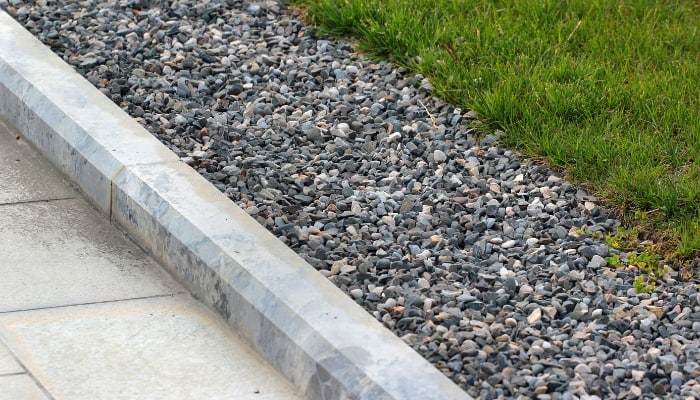
A gravel border is ideal for rock gardens, but you can also use it to define flower beds and other ornamental areas in the lawn or landscape.
Gravel is cheap and readily available, and it doesn’t require other materials like concrete to hold it together. Use gravel around a flagstone patio, walkway, and garden spaces to lend a natural look.
7. Plastic Edging
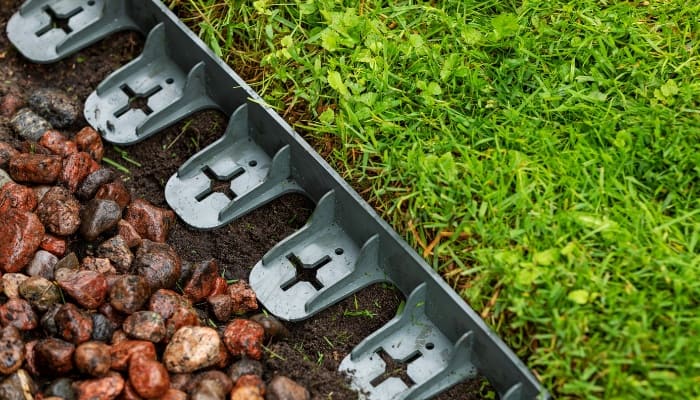
Plastic edging isn’t the most durable option, but it’s budget friendly and comes in a wide variety of colors, sizes, and designs.
It’s easy to install and can be removed just as quickly. However, it doesn’t do well with pets since it’s rather fragile, so you might look for a more robust edging solution such as gravel or rocks if you have dogs or cats.
8. Metal Edging
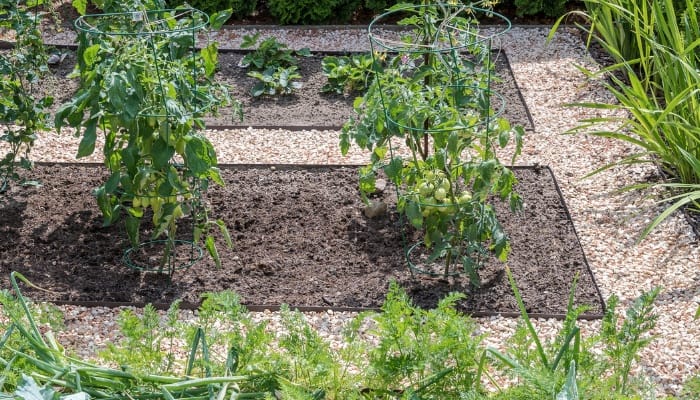
Speaking of robust and durable edging solutions, metal edging stands the test of time, the elements, and precocious pets.
Metal also has the advantage of taking up less space than rocks or concrete and is a low-profile option in terms of visibility.
You can use metal edging to divide areas within the landscape as well as the outer borders of the garden.
9. Rubber Edging
Rubber edging is another way to make your borders look stylish without having to spend too much time or effort installing the rubber.
When done properly, rubber edging can last for up to 20 years. Rubber is easy to shape and curve around the corners and edges of the border. You can even do it yourself and save on labor fees.
10. Pre-Formed Wood Edging
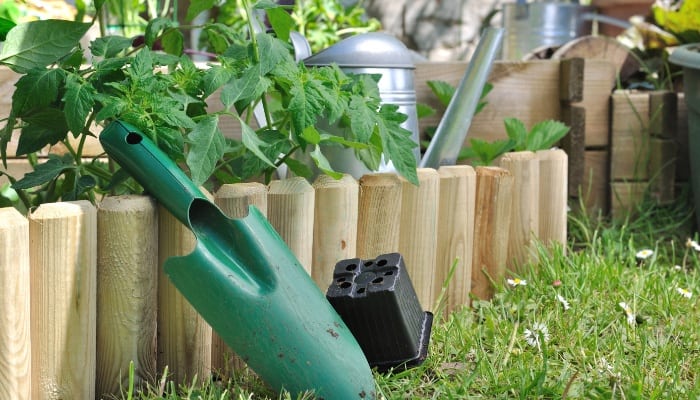
When it comes to the natural look and feel, nothing beats wood. In terms of color and texture, wood is excellent in conveying that rustic look.
Pre-formed wood comes in various sizes, designs, and shapes. It also has different colors and textures to suit every landscape.
11. Bamboo Border
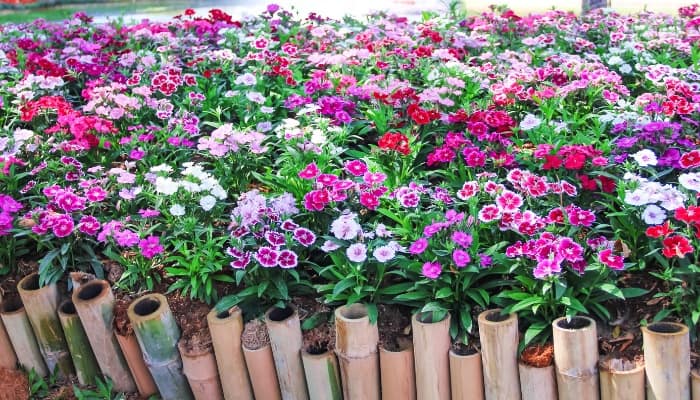
Bamboo is another recommended option for edging. Much like pre-formed wood, bamboo borders come ready to install.
Some borders have different bamboo heights to create a fascinating border for the patio, gazebo, or flower bed. Since bamboo is a natural and durable product, it requires minimum maintenance.
12. Landscape Timbers
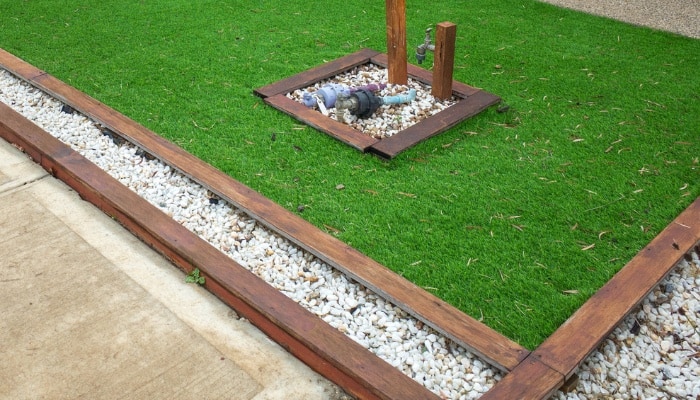
Timber often comes untreated with its natural color. It can be a little tricky to install since it needs hardwood stakes to secure it in the ground, but once installed, it shines with its rustic beauty and natural wood patterns.
You can have a professional install them, but anyone with a few simple tools and a little know-how can easily do it themselves.
13. Railroad Ties
If you’re looking for a cost-effective way to define your yard or landscape without the hassle of cutting and shaping the wood, then railroad ties are a good option.
They come pre-cut and in the same size. However, they’re usually packed with chemicals, so it’s not a good idea to use them inside a vegetable garden.
14. Decorative Fencing
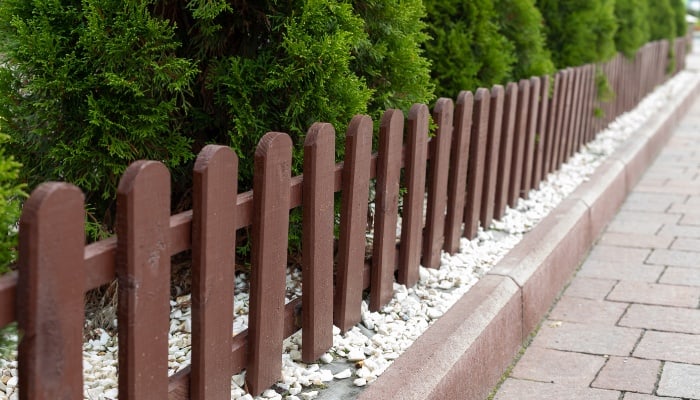
Decorative fencing, as the name implies, puts a lot of emphasis on the ornamental part of the border, so you can safely use them around the various areas in your landscape.
They are available in a wide variety of designs and different materials including wood, metal, and bamboo and are easy to install.
15. Woven Branches
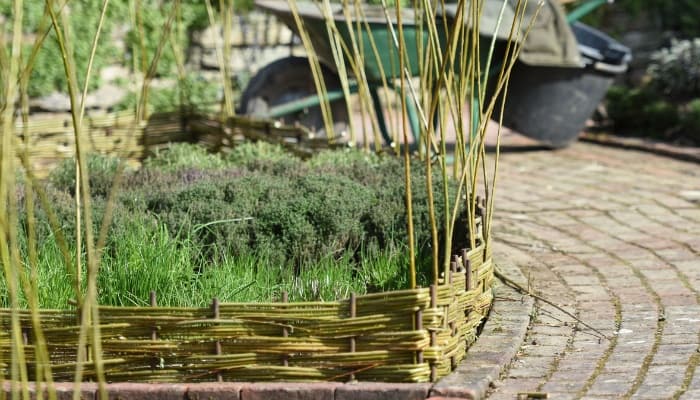
Woven branches or wattle edging is gaining popularity among gardeners and landscapers these days.
If you have the right trees at your disposal, then you have abundant material to make your wattle edging at no cost.
By layering the branches alternately and following a strict design, you’ll have a border that weaves through the landscape.
16. Scrap Wood
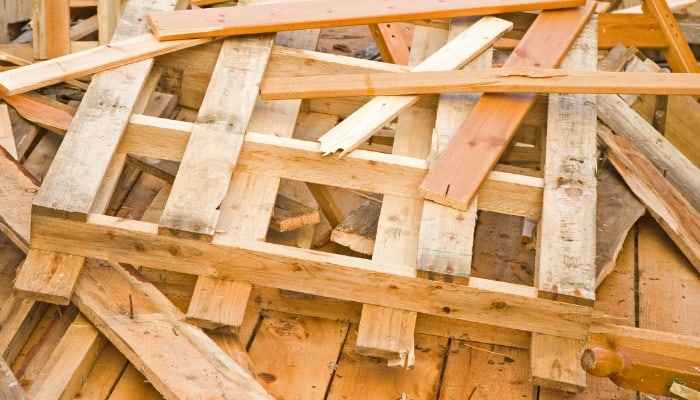
Scrap wood is often discarded by sawmills since it’s of no use to them, but you can collect the wood pieces and use them to build a border in the same way you’d use gravel.
Mix and match the timber textures and patterns to create a unique design for each border.
17. Logs
Logs have the same functionality as railroad ties, but since they have no chemicals, they’re safer to use both as outside borders and area edgings.
Logs are often less wieldy than other wood edging options, and you may need power tools to cut and shape them.
18. Seashells

If you like to use gravel to create landscape borders, then you’d enjoy using seashells for the same purpose.
Seashells can be an elegant edging solution and have a wide variety of colors and patterns. However, they’re rather brittle and might be damaged easily.
19. Empty Wine Bottles
While recycling is all the rage these days, there are other ways you can put those empty wine bottles to good use. Just plant them in the soil to circle the flower bed or create a colorful edge around the veggie patch.
Be aware that, much like plastic and seashell borders, empty glass bottles are fragile and might break if you’re not careful when working the soil around them.
20. Weed Mat Edging
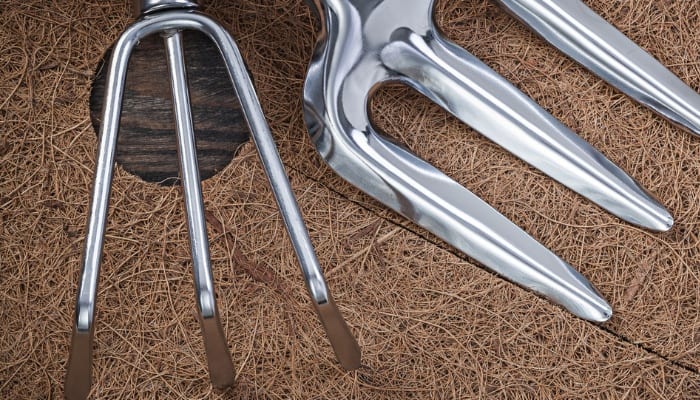
Weed mats were originally designed to keep weeds out of beds, but you can also use them to redefine your garden areas and landscape designs.
They’re made of coco fibers, so they blend in easily with the landscape and don’t pose any hazards to the plants or pets in the house.
21. Old Flower Pots
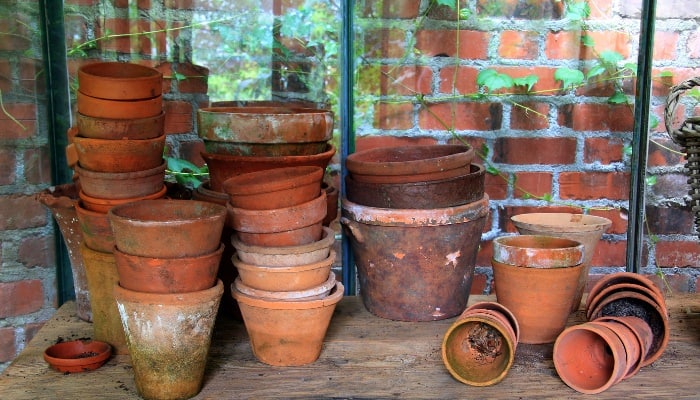
Most people throw old flower pots in the trash. Unlike empty glass bottles, they have no recycling value, but you can use them as decorative elements to redefine the borders in the garden.
Make sure they’re sterilized, especially if they had sick plants in them, before you line them around your flower beds.
22. Tumbled Glass for Landscaping
Tumbled glass gives your landscape just the right accent. It’s pleasing to the eye and sturdy enough to handle heavy foot traffic.
Make sure it’s not slippery, and choose the right color that matches your landscape. Tumbled glass can be expensive, so perhaps consider using it for smaller garden designs.
23. Trench Edging
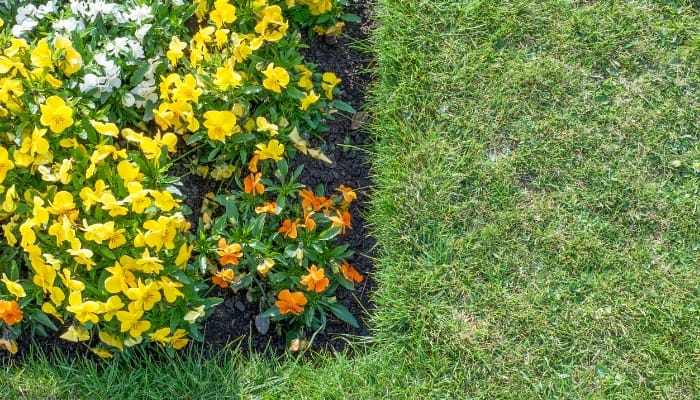
Trench edging is one of the simplest ways to create a well-defined edge within and around your landscape. All you need is a flat-edged shovel and a few hours of your time.
Dig the trench straight down on the side of the lawn and at a 45-degree angle on the side of the garden.
24. Cinder Blocks
Cinder blocks are another common item that you can use to solve your landscape edging problem. They’re not expensive and are easy to paint if desired.
They can also tolerate moisture, rainfall, and snowfall without rotting or disintegrating.
An added bonus is that the holes can be used as planters, so you can add even more color to your garden, or plant creeping plant varieties that will spill over the edge to add visual appeal.
25. Polycarbonate Roofing Panels Cut To Size
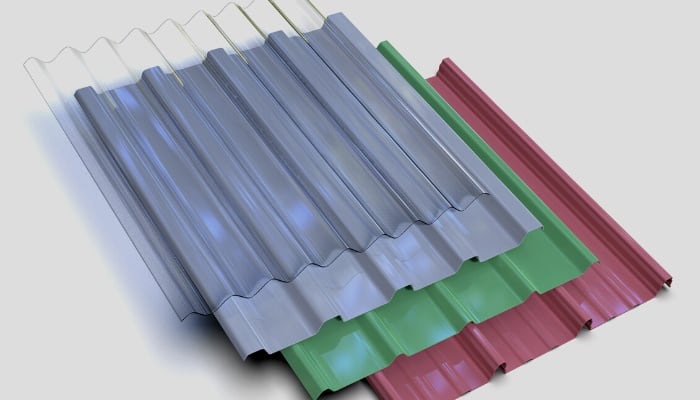
Polycarbonate roofing panels are quite ornamental and sturdy. The only drawback is that they are too big to use as is. However, you can cut them to the sizes that match your design.
I recommend cutting them in various sizes to create an uneven border for an eye-catching design.
26. Gabion Wall Edging
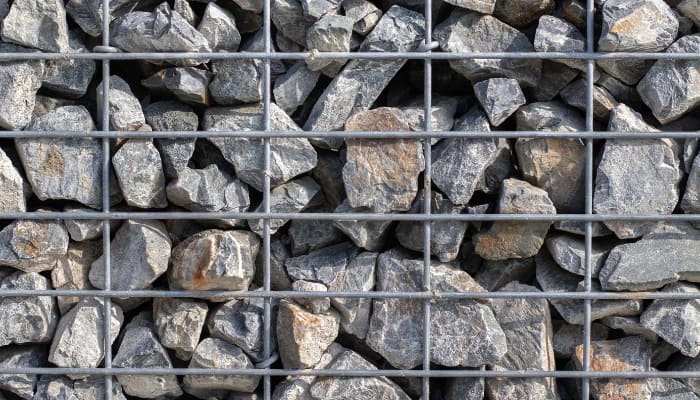
Last but not least, you can build a gabion wall. It involves a bit of work, materials, and skill. You’ll need rocks of different sizes and one or more sturdy wire cages, depending on your design plans, to form the wall and contain the rocks.
Conclusion
Landscape edging doesn’t have to be costly or involve a lot of work. You can use any materials lying around such as cinder blocks, discarded plant pots, wood scraps, gravel, or seashells.
If you prefer a more elaborate edging, you can go for tumbled glass, decorative fencing, or something else entirely! When it comes down to it, you’re really only limited by your own creativity.

